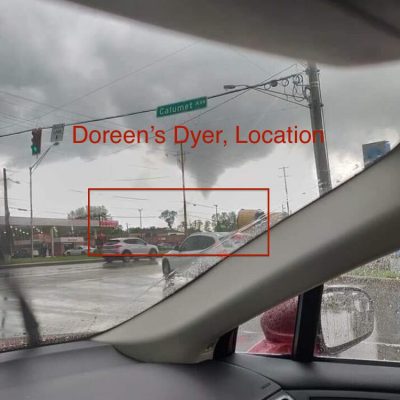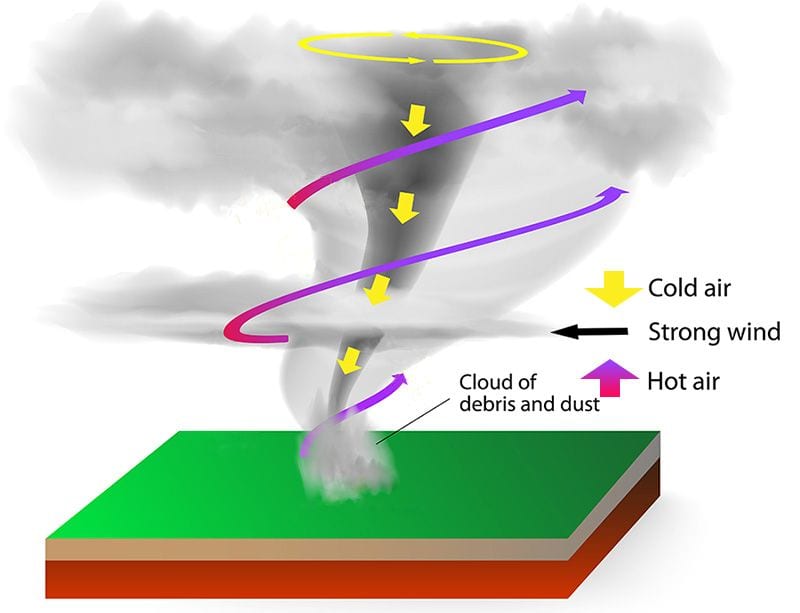How to Stay Safe During A Tornado

Figure 1
Recently, on Memorial Day, the Chicago and Northwest Indiana region witnessed storms that brought rain,hail, high winds, and even Tornadoes.
In the east area of Sauk Village and the southwest of Dyer, Indiana, a tornado touchdown was confirmed on Memorial Day afternoon.
If you refer to the image (Figure 1), you will see our store at the Doreen’s Dyer, IN location was almost taken out by this tornado.
Indiana is quite prone to tornadoes and people are familiar with the destruction these twisters are capable of producing.

Figure 1
Local History of Tornadoes
Historically, June holds the record for the most tornadoes in Indiana on any given day and for the most in a single month i.e 44. In June 1990, the largest outbreak of tornadoes hit Indiana; thirty-seven tornadoes across thirty-one counties, killing eight people and resulting in 200 casualties.
But even after repeated warnings and forecasts, people don’t take heed to precautions during a tornado. Particularly, those living in urban areas and metropolitan parts of the state assume that tornadoes won’t hit them. Well, as it turns out it’s a common myth which can be fatal if the facts are not clarified.
Tornadoes strike large metropolitan areas with a high relative frequency. In 1999, an F-5 tornado spread through Oklahoma city, and in 2007, an F-2 tornado crossed via Atlanta, Georgia. Recently, an incredibly fierce F-4 tornado traveled from Tuscaloosa to Birmingham,Alabama in April. Tornadoes are not affected by any structure or terrain. In fact, tornadoes hit large cities less frequently because there are fewer cities when compared to the size of rural areas in the U.S.
Moreover, a study conducted by the American Geophysical Union in 2017 considered the urban risks from tornadoes. The study found that cities in the Midsouth are more likely to face casualties from tornadoes. The results of this study are similar to the findings of Northern Illinois University from nearly a decade before. You can know more about the myths related to tornadoes over here.
Let’s understand more about tornadoes and their origin.
What Exactly are Tornadoes & How are they Formed?
Simply put, tornadoes are usually the extreme version of a supercell thunderstorm. During the storm, cold air and warm air combine together in a set pattern; the cold air drops and the warm air rises. Eventually, the warm air twists into a spiral and forms the funnel cloud that we all know as a tornado. (Figure 2)
A tornado is formed in several steps. First, there is a change in wind direction and an increase in wind speed. This creates an illusion of horizontal spin in the atmosphere. Next, the air rises within the thunderstorm and starts rotating from the horizontal to vertical direction.

Figure 2
Now, a 3-10 km of the land is contained within a vast part of the storm. This is where the strongest tornadoes form. Then, a low cloud base in the center of the storm becomes a rotating wall cloud and this part is rain-free. Lastly, a tornado develops and begins its destruction.
Now that you know what are tornadoes, let’s take a look at the difference between watch and warning.
Tornado Watch vs. Tornado Warning
During a natural calamity, it is important to understand certain concepts like a watch and a warning. Watches and warnings are issued to the public based on different criteria.
Tornado watches are issued for large areas where conditions are favourable for a tornado to occur, while tornado warnings mean that a tornado imminent or has been detected on radar and are generally issued to highly localised areas.
Usually, watches are issued a few hours before the storm might hit and are meant to alert the public of a potential threat, thus alerting them to remain cautious. On the other hand, warnings are issued minutes before a tornado strikes and are urgent signs to seek shelter in a safe place.
The sources for issuing watches and warnings are also different. For instance, watches are issued by NOAA’s Storm Prediction Center (SPC), whereas warnings are issued by local offices of the National Weather Service(NWS).
How to Stay Safe During a Tornado
It’s better to be prepared than to face an unpleasant surprise. This is absolutely true in a deadly event such as a tornado. Let’s have a look at how you can take the necessary precautions and prepare yourself for a tornado-
- Keep yourself updated by listening to the local area radio, NOAA radio or TV stations for the latest news.
- Make an emergency kit and put the necessary medications, snacks, torch, etc. Keep it handy.
- Watch out for tornado danger signs such as dark, greenish clouds often caused by hail.
Once you know that a tornado is on its way, your next step should be to move to a safe place. Here’s how you can stay safe at different places.
House
If you are in a house, the safest place to be is on the lowest floor, i.e your basement. It should be away from windows and with as many walls as possible between you and the outdoors.
If your house doesn’t have a basement, then the safest place would be a bathroom or a closet.
Office or mall
If you work in a multi-story building and getting down to the ground floor during a storm is not possible, then you can try the following options:
First, get away from the windows as much as you can. Than find shelter in the copy room, supply room, conference room or a bathroom. A stairwell will also work for this purpose.
Car
The first thing you should do if you are in your car during the storm is to seek shelter inside a building. But, if you are stuck inside the car, the next best thing would be to drive away from the storm in a perpendicular direction. Do not make the mistake of protecting yourself by driving under a bridge or an overpass. It is dangerous to seek shelter under a bridge because the twister gets more funneled and accelerated as it passes under the bridge.
Conclusion:
We hope this guide helps you understand how to keep you safe during tornadoes.
We never want these tragic tornadoes to happen, but it’s better to prepared than not be!
Give us your opinions about the latest tornadoes and wacky weather in the region!
Share
Sources
History of tornadoes in Indiana
https://www.indystar.com/story/news/history/retroindy/2014/03/18/tornadoes-indiana/6528605/
What are tornadoes & how do they form?
https://www.universetoday.com/75695/how-do-tornadoes-form/
Difference b/w watch and warning
https://www.weather.gov/safety/tornado-ww
How to stay safe
https://www.redcross.org/get-help/how-to-prepare-for-emergencies/types-of-emergencies/tornad
Staying safe in different locations
https://www.google.com/amp/s/www.govtech.com/em/preparedness/What-to-do-During-a-Torna
do-Warning-if-Youre-in-a-House-Apartment-Office-or-Car.html%3fAMP

